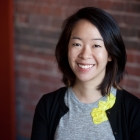As a Hyphen staffer for most of the past nine years, Sita Kuratomi Bhaumik knows about survival. She was Takeout editor in our early years and then returned for a second tour as editor of Artwell in 2009. She has since been dedicated to showcasing some of the most compelling contemporary Asian American artists. Bhaumik is sadly leaving Hyphen to focus on her duties as a Kearny Street Workshop board member and on completing her master’s thesis on the role of food in the construction of identity in contemporary art. But, Bhaumik says, “I’m sure there will be a third tour.” Spoken like a true survivor.
Since joining Hyphen in 2010, Jericho Saria has proven to be a versatile editor across various sections, including First Person, Lazy Susan and People. This is his last issue with us, but you can continue to see his work on Pusong Pinoy Sa Amerika, an immigration law advice show for the Filipino community, where he is a producer. Saria became a two-time Jeopardy! champ last June.
For the past two and a half years, music editor Margot Seeto has sought to expand the popular conception of Asian American music, through stories ranging from Middle Eastern rock bands that have found asylum in the U.S. to an ethnomusicology student who is breaking jazz barriers in Japan and America. Seeto called working with Hyphen a dream come true: “The philosophy of the publication fits much of my identity to a T.” We bid the Honolulu-based editor a fond aloha after this issue.
In this issue’s First Person, Meeta Kaur writes about the survival of wearing turbans in the Sikh tradition. “The misinformed association between terrorism and Sikhs has caused havoc for Sikh Americans,” says Kaur, who was motivated to address the chasm between the perception of Sikh men inside their homes and the mass media’s portrayal of them as terrorists. “Sikh American men are like all the other guys out there. They just happen to be preserving turbans and beards as part of their spiritual faith.” The Union City, CA-based writer is currently at work on a piece about her son and the bullying that Sikh children experience in school.
While illustrating our discussion on the survival of Asian American poetry, Julia Kuo saw similarities to the debates within Asian American art about the benefits and pitfalls of “going mainstream.” “You could have gone through the article and replaced every ‘poet’ with ‘artist’ and the conversation would apply itself in the exact same way,” the Cleveland-based artist says. “It's great to think about the bigger picture of how Asian Americans are finding their voices in the arts today.” Kuo is the author of the children’s books Clara Lee and the Apple Pie Dream (2010) and Everyone Eats (2012). Her work has appeared in The New York Times and CMYK magazine.
Catherine A. Traywick’s story on Filipino nurses in San Francisco battling workplace discrimination exemplifies this issue’s theme of survival. “The article is about the survival of a beloved hospital, the survival of a profession that is facing sweeping changes and budget cuts and, more subtly, it’s about the many different things that immigrants and their families do to ensure their own survival, whether that means losing your ancestral language, leaving the only home you've ever known or working the longest hours and the worst shifts for the lowest pay,” the Berkeley, CA-based writer says. Traywick’s work has been published in Ms. Magazine and The Huffington Post.
Jenifer K. Wofford has created artworks focused on Filipina nurses for the past five years. “Nurses rock,” says the San Francisco Bay Area-based artist, who revisited the subject for this issue’s feature on discrimination against San Francisco nurses. “Both the article and my illustration show that survival depends on taking action — speaking truth to power, and not being passive or deferential.” Her work has been exhibited at the Berkeley Art Museum and Yerba Buena Center for the Arts. She is currently working on illustrations for The Bold Italic magazine and Samantha Chanse's upcoming book Lydia's Funeral Video.
Photographer Corky Lee has spent the past 40 years capturing powerful images of Asian Pacific Americans, primarily on the East Coast. For this issue, he braved the Gulf Coast to investigate how the Asian American community there is surviving after Hurricane Katrina and the 2010 BP oil spill. “New York City’s Chinatown got through the aftereffects of 9/11 but is far from being revitalized,” Lee says. “I see the same conditions in the gulf region. It will take many years of recovery to get back to happier days. I hope that by publishing these images that journey will be a little shorter and less painful.”
As a filmmaker, Timothy Tau views the craft of acting with admiration and fascination — a sense he hoped to convey in “The Understudy,” his winning submission to the 2011 Hyphen Short Story Contest. As for the survival of Asian American actors, artists, writers and filmmakers, Tau believes that race should not be a handicap but rather an advantage. “The revolution in films and literature will come from people who are not afraid to tell stories that reflect the diversity of the Asian American experience and who do not confine themselves to accounts that have been told ad nauseam from the community.” The San Diego-based Tau previously received second place in the 2010 Playboy College Fiction Contest.







Comments